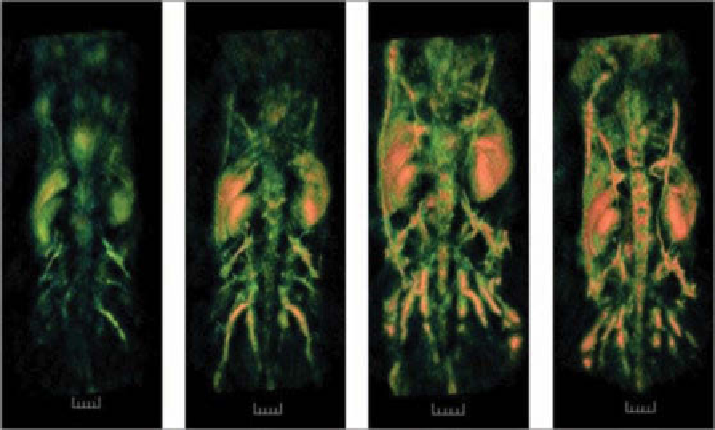Biomedical Engineering Reference
In-Depth Information
discussed using OA imaging techniques to observe the pattern of optical absorption
in mouse brain regions [33]. These studies represented an important step for OA
imaging, suggesting that this imaging modality showed promise for applications in
neurophysiology, neuropathology, and neurotherapy [39]. The central neuronal
system tissue contrast in addition to blood vessels also revealed other brain structures
such as the cerebellum, hippocampus, and ventriculi lateralis [32, 39]. Recently, non-
invasive, high-resolution imaging of mouse brain activity has been reported [40, 41].
With endogenous hemoglobin as the contrast agent, a contrast-to-noise ratio of 25 dB
(decibels) was achieved [40].
Hemoglobin-based PA imaging has been shown to facilitate the monitoring of
many biological processes of clinical importance. In burn recovery studies, for
example, a two-wavelength OA imaging technique was used to discriminate coagu-
lated and noncoagulated blood in a dermal burn phantom [42]. coagulation and
deoxygenation of blood could be related to OA changes, as demonstrated by
TomoWave Labs [38] in the OAT visualization of the whole body of a mouse from
life to postmortem (fig. 5.2. Different optical absorption spectra of coagulated and
noncoagulated blood produce OA signals of varied amplitudes, which could be
utilized to differentiate blood samples. multiwavelength OA measurements were
performed to monitor the wound healing process of extensive and deep dermal burns
in rats [43] suggesting that the multiwavelength approach could be useful for moni-
toring the changes in local hemodynamics including angiogenesis (the formation of
new blood vessels in the wound) during wound healing.
The imaging of angiogenesis in cancer is another important application for
hemoglobin-based OAT [13, 40]. The tumor growth is generally dependent on
Live
Dead 5 min
Dead 2 h
Dead 1 day
5 mm
5 mm
5 mm
5 mm
figure 5.2
Postmortem changes of optoacoustic images of the mice. (Adapted with
permission from Ref. [38]. © sPIe-International society for Optical engineers.)

Search WWH ::

Custom Search